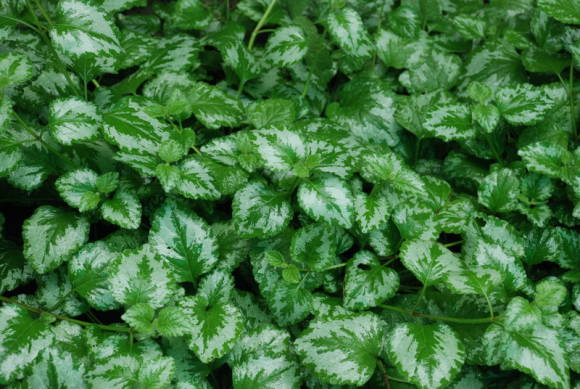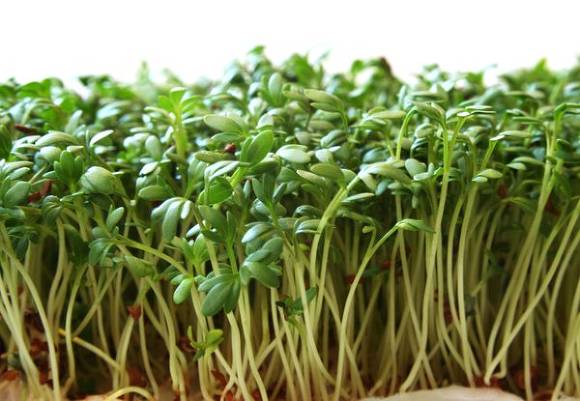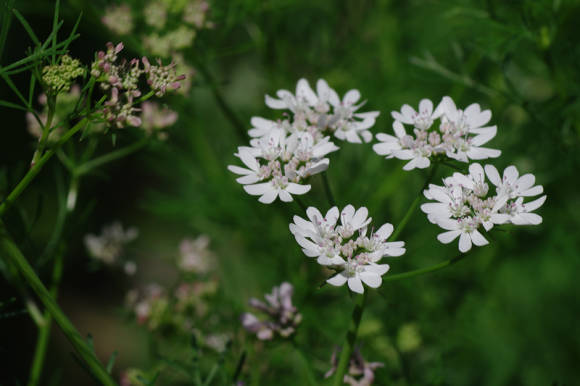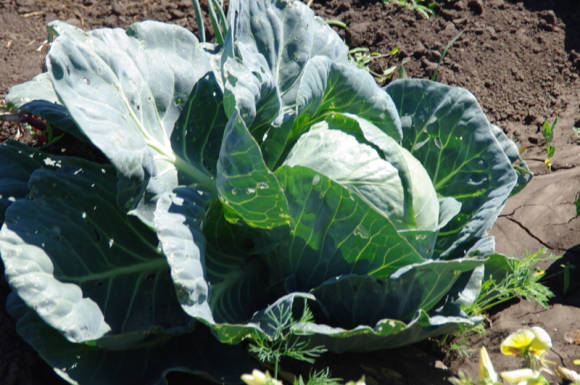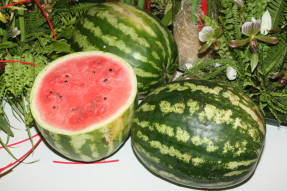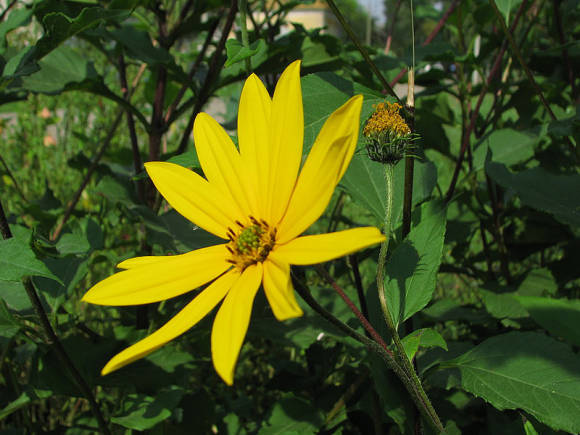Apple moth (Cydia pomonella) is one of the most harmful insects. It is a small butterfly with dark gray front wings on which dark transverse wavy lines are located, and at the top there is a brown spot with a bronze tint. The hindwings are light, with fringes along the edges. In span, the butterfly reaches 20 mm. The caterpillar is yellowish or pinkish with a dark head and occipital plate. Adult caterpillars reach 12–18 mm. One moth caterpillar damages at least 2-3 fruits. Damaged fruits become wormy, their passages in the pulp fill with excrement. From the fruit pulp, caterpillars enter the seed chamber, eating 2-3 seeds each and leaving their shells intact. Damaged fruits fall off prematurely, lose significantly their qualities and storage capacity. Fruit damage in the absence of serious protective measures can reach, according to the observations of experts, in some cases 80–90%, indicating an extremely high harmfulness of the codling moth.
 |
The moth's butterflies' years begin during the flowering period of the apple tree and lasts 1.5–2 months, in our Urals it usually coincides with the end of its flowering in the second half of May – early June. First, males appear, after 2-3 days females fly out, puberty of which lasts 2-3 days. At the same time, they feed on droplet liquid moisture, and dishes with water or fermenting molasses attract butterflies, which can be used to catch them. To attract males, mature females secrete pheromones, starting to lay eggs after fertilization 3-5 days after leaving the pupa. Oviposition lasts up to two weeks. During this period, each female of the overwintered generation lays 40–120 eggs, immediately after sunset at a temperature not lower than + 15.5 ° С. This is one of the most vulnerable periods in the life cycle of the codling moth, in which it is desirable to use substances that scare away and disorient the egg-laying process. These methods include the smoke of the garden area with the addition of tobacco, wormwood or other specific repelling plants to the mixture of plant residues, spraying trees with solutions or infusions of such plants or synthetic repellents with low toxicity to humans, hanging these plants or repellents in the tree crowns. It may also be effective to cultivate 2-3 plants of wormwood, tansy, Lobel's hellebore and the like under each apple tree, which also scare away the female codling moth, making it difficult to lay eggs.
The main feature of using the methods of scaring away the moth during the period of its oviposition is that they should be carried out only at dusk, after sunset at an air temperature of at least + 15.5 ° C, when butterflies are actively laying eggs, since during the day our butterflies are motionless sit in the crown of trees. However, in the south, where, unlike our zone, there are several generations of the moth, butterflies of subsequent generations fly during the day. During oviposition, females place eggs one at a time, according to the observations of specialists, usually on the smooth surface of leaves (up to 96%) and young shoots (1-2%), after which, when the fruits become smooth too, mainly on the fruits. Given this feature, it is important that the repelling substances during the laying period have good fumigation (fumigating) properties, covering the surface of all aerial parts of the apple tree.
 |
In 5–10 days after laying, depending on the air temperature, the sum of effective temperatures above + 10 ° С - 230 ° С is required, caterpillars hatch from the eggs, which actively crawl for 1.5–2 hours in search of the place of introduction into fruits. For effective control of moth caterpillars, it is especially important to know the date of accumulation of the indicated sum of effective temperatures.An effective temperature is considered, which is the difference between its average daily value and the value of the lower threshold for the development of the moth (its biological zero). Observations have established that the temperature equal to + 10 ° C should be considered as the lower threshold: only with the transition of its average daily value above + 10 ° C does the spring development of the moth begin, therefore, when organizing observations, the calculation of the sums of effective temperatures should begin in the spring from the moment of the transition of the average daily value through + 10 ° С. From this date, it is necessary to summarize daily effective temperatures (the difference between the average daily temperature and the lower development threshold). So, for example, if the average daily temperature turned out to be + 13.5 ° С, and the value of the lower development threshold is + 10 ° С, then the effective temperature for that day turns out to be 13.5 ° -10 ° = 3.5 ° С. It has been established that by the time of accumulation of 130 ° C of effective temperatures in spring, a butterfly emerges from the pupa. By the time the effective temperatures reach 230 ° C (above + 10 ° C), caterpillars develop from the eggs laid by the butterfly, and they begin to invade the fruit. With the onset of this moment, apple trees already need to be actively treated with appropriate chemicals designed to combat the moth.
The method for calculating effective temperatures is simple and readily available to every gardener. Moreover, many live on their plots from spring to late autumn. Summing up these residual (effective) temperatures from the day when the average daily temperature passed through + 10 ° С, it is possible to determine the date of accumulation of 130 and 230 ° С effective temperatures, which will indicate the timing of protective spraying. Observations of the temperature are carried out directly in the garden, using for this a conventional thermometer with two-time readout of temperature information during the day or special maximum and minimum thermometers. The sum of two measurements of an ordinary thermometer taken during the hours of maximum and minimum daily temperature and measurements of the maximum and minimum thermometers, divided by two, will give the value of the average daily temperature. In order to avoid the influence of direct and scattered solar radiation, thermometers are installed in a protected special box with lattice grids at a height of about one and a half meters. When using the minimum and maximum thermometers, the minimum thermometer is placed in the box at night, and the maximum for the day. This shift is carried out daily during the entire observation period. Such observations of the temperature in the garden are also very useful for the purposes of research on plant phenology.
 |
Along with the control and summation of effective temperatures, there is an even simpler way to determine the date of oviposition by moth moths, which is as follows. Since autumn, the caterpillars of the moth that have climbed into the trapping belts are collected and placed in a jar with wet sawdust. The jar is stored in the barn until spring. In the spring, the jar is covered with gauze and placed in the garden under a canopy. At the same time, they observe the departure of butterflies. The departing butterflies are carefully deposited from the jar into a gauze sleeve put on a branch with fruits, where they observe the beginning of egg laying and hatching of caterpillars. These observations are the most reliable and make it possible to determine the best timing for the most effective control of the codling moth. It should be borne in mind that some of the pupae remaining in the bank, from which butterflies did not fly out, do not need to be destroyed and discarded. Somewhat later, small parasitic insects will appear from them - the egg-eating trichogramma. They should be released into the garden, thereby ensuring the biological protection of some part of the fruit from this pest.
Caterpillars of the moth usually enter the fruit through the calyx or through the petiole fossa, through wounds on the skin of the fruit, often under the cover of a leaf, or between two or a group of fruits touching each other.Before entering the fruit, the caterpillars attach themselves with a cobweb, gnawing a hole shallowly under the peel, in which they live for 2-3 days, feeding on the pulp of the fruit. The inlet of the caterpillar is sealed with a cork made from fruit stubs and excrement. The latter remain on the surface, making the insertion points of the tracks well visible. After the first molt, the caterpillars gnaw through the course to the seed chamber, where they molt again after 5–6 days. Feeding on seeds, caterpillars molt two more times with an interval of 9–10 days. Caterpillars of the last two generations crawl from fruit to fruit, rising at the same time from damaged fruits that have fallen to the ground again to the trees and damaging 2-3 fruits in large-fruited varieties, 3-4 fruits in ranetki and semi-crops, and 4-5 in Siberian apple fruits. The average duration of development of caterpillars in fruits in our zone is about 45 days.
Damaged fruits fall to the ground, and caterpillars that have finished growing leave them during the day in search of a place for cocooning. The codling moth overwinters in the caterpillar phase in a dense cocoon made of cobwebs and other auxiliary material (soil, wood). Wintering sites are very different. In old gardens, up to half of the caterpillars overwinter under the peeled bark of boles and in cracks at a height of up to 60 cm from the soil surface, and the rest - in the soil of tree-trunk circles, as well as in pieces of humus, backwaters, chatals, sticks, stumps, various buildings and other shelters ... In young orchards, caterpillars overwinter mainly (up to 90%) in the soil of trunks, at the root collar at a depth of 3–10 cm. In addition, caterpillars overwinter in packaging material, in containers, in fruit storage rooms, where they get with damaged apples ...
The number and harmfulness of the codling moth is greatly influenced by climatic conditions. In severe winters with little snow, at temperatures below -25 ° C, up to 80% of the caterpillars can die. Rainy cold or windy weather in the spring and summer severely inhibits egg laying. Poor fruiting, which does not provide feed resources for caterpillars, also negatively affects the number of the pest. Diseases, insects, predators and parasites also strongly affect all this. Many caterpillars and pupae of the moth dies in different periods from parasitic insects, the number of which reaches more than 20 species. Many caterpillars in wintering grounds die not only from the cold, but also from fungal diseases. In the spring, after laying eggs, up to 64% of them are destroyed by earwigs, predatory bugs, lacewing larvae and trichogramma. Before being introduced into fruits, up to 50% of caterpillars die from predators - larvae of lacewings, ladybirds, ants, predatory bugs. Rainwater (during heavy rains) washes them to the ground, where most of the caterpillars die. But their death is especially great during long dry periods (up to 100%), when the air humidity becomes less than 30%. The total death of caterpillars before their introduction into fruits in different years in the northern zone of horticulture, according to experts, ranges from 63% to 82%.
 |
Main long-term and annual measures in the fight against the codling moth
Long-term measures include the following:
- Increasing the number and activity of entomophagous insects by creating a flowering conveyor of entomophilous and nectar-bearing plants in free areas near gardens, garden and summer cottages (hawthorn, mountain ash, irga, blackthorn and others) and in the aisles of gardens at different times (phacelia, buckwheat, mustard ), as well as partial or complete turfing of gardens with the inclusion of alfalfa, clover, fescue. Above, I have already noted that the pupae and caterpillars of the moth destroy more than 20 species of entomophages.
- Preservation of the number and activity of entomophagous insects when using pesticides in the garden, in the garden and suburban areas by creating a reserve area or area there, where, after flowering, plants are processed only with biological products.Such plots or plots fulfill the filtering role of delaying pests and passing entomophages from the reserve to the rest of the garden and plots.
- Gardening with resistant and slightly damaged apple moth varieties. In the Sverdlovsk region, studies to assess the resistance of different apple varieties to damage to their fruits by the moth were not carried out, therefore, such data are absent. From my own experience, I can say that these are mainly only separate autumn and winter varieties of apple trees. Gardeners themselves can identify these varieties. Such a laying of the garden allows you to preserve entomophages on resistant varieties, which subsequently spread throughout the garden.
- Interrupting or limiting the overwintering of caterpillars by stimulating the reproduction of natural populations of muscardine mushrooms, maintaining high soil moisture by watering, especially in young gardens.
 |
The following measures should be taken annually:
Conducting disorientation of egg-laying by female moths by capturing them in vessels (jars) with water or with wandering baits and scaring away the smoke from the garden. At night, in the crowns of apple trees, you should hang jars with wandering baits (1/3 liter jar filled).
The bait recipes are as follows. Take 600-700 g of apples or 100 g of dried fruit, pour 2 liters of water and boil for about 30 minutes, then add 0.5 liters of whey, 0.5 liters of bread kvass, 20-25 g of yeast, 250 g of sugar and put to a warm place. The bait is ready when the liquid begins to ferment.
Another recipe: put 200-300 g of rye bread crusts, 3-5 lumps of sugar and a little yeast in a three-liter jar, pour water over it, cover with gauze and put the jar in a warm place. After 1-2 days, the composition is ready. The liquid is drained, and bread and sugar are again put into the sediment, water is poured. The fermented thick is diluted with water and used as bait.
Banks, so that daytime beneficial insects do not accidentally fall into them, are hung out for butterflies of the codling moth only in the evening. In the morning, the banks are removed, the trapped butterflies are taken out of them, the bait mixture is poured into a closed container and stored in a cool place until the evening. In the evening, liter cans are again filled with this mixture and hung out in the crowns of trees, and such an event is carried out daily, be sure to monitor the air temperature so that it is not lower than + 15.5 ° C.
Smoke is carried out as follows. Small heaps of straw or manure are placed in the aisles of the garden, one per 100 square meters. m. They are filled with 1.5-2 kg of tobacco dust, wormwood, tansy, hellebore Lobel, tomato tops, which have repellent and insecticidal properties against the codling moth and other pests. Achieve smoldering heaps of straw and other substances with intense smoke after sunset at dusk at a temperature not lower than + 15.5 ° C. This event is most effective if it is carried out simultaneously on the entire garden array of plots for at least 2 hours a day, 2-3 days after the departure of males caught on wandering baits.
The use of other measures to disorient and scare away moth butterflies:
- To combat caterpillars, 15–20 days after the flowering of winter varieties or, if monitoring the development of the pest or control of effective temperatures is carried out, then a week after the start of egg laying, the apple trees should be sprayed with Karbofos (75–90 g per 10 l of water), INTA-VIR (1 tablet per 10 l of water), Fitoverm (2 ml / l per 10 l of water), Lepidocide (20-30 g per 10 l of water) or other insecticides. The second treatment with these drugs is carried out after 10-14 days. In addition, spraying apple trees with infusions of wormwood, decoctions of tomato tops, milkweed, yarrow, delphinium, burdock, chamomile, tansy several times after three days can be used with less efficiency against caterpillars during the period of their mass appearance.
- Cleaning, collection and destruction in autumn or early spring of lagging dead bark. Systematic collection and processing of volunteers.Disinfection of fruit storages, containers, packaging material, supports, chatal, various objects in the garden, walls of buildings, fences up to a height of 60 cm skeletal tree branches.
- You can fight the moth using trichogramma, if there is a possibility of acquiring it. The release of the egg-eater with a rate of 2–2.5 thousand per 1 hundred square meters is carried out in three periods: at the beginning of oviposition, in the middle of mass oviposition, and 6 days after the second release.
- To increase the physiological resistance to stress, early spring feeding of apple trees with nitrogen fertilizers mixed with trace elements, especially boron and zinc.
In conclusion, I want to say that the apple moth damages not only the fruits of the apple tree, but also the fruits of pears, quince, apricot, less often plum, peach, walnut. Therefore, the fight against it may not be limited to one apple tree.
The newspaper "Ural gardener" No. 2-3 - 2015

